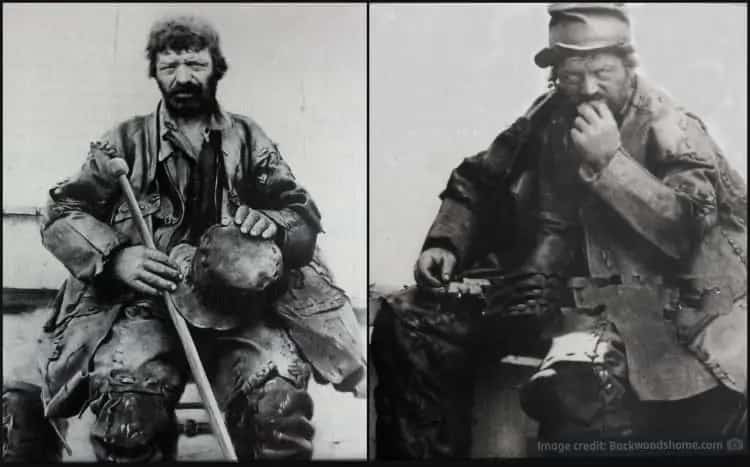Who Was the Leatherman, the Mysterious Nomad of the 1800s?

In the 1800s, a mysterious man known as the “Leatherman” became a well-known figure in the northeastern United States.
He was famous for his predictable travels through New York and Connecticut, where he walked a strict 365-mile loop year after year. Dressed entirely in a suit made of leather, he became a local legend. But despite his fame, no one knew who he truly was or where he came from. Even today, the Leatherman remains one of history’s most intriguing mysteries.
The Life of the Leatherman
From 1857 to 1889, the Leatherman walked through the countryside of Connecticut and New York. At first, his travels seemed random, but over time, he settled into a strict routine. He walked a 365-mile loop between the Hudson River and the Connecticut River, completing the journey in about 32 to 34 days. He walked over 10 miles every day, rain or shine, and his schedule was so precise that locals could predict exactly when he would pass through their towns.
The Leatherman was known for his unique appearance. He wore a heavy suit made of leather scraps, which he likely stitched together himself. The suit weighed between 60 and 70 pounds and protected him from the harsh weather. He slept in caves and under rock ledges, rarely accepting shelter from others. Despite his rugged lifestyle, he was polite and grateful when people offered him food, tobacco, or leather scraps. However, he almost never accepted money.
The Mystery of His Identity
The Leatherman’s true identity remains unknown. He spoke very little, and when he did, it was in broken English or French. Many believed French was his native language, but no one could confirm this. Over time, people began creating stories about his past to explain his unusual lifestyle.
One popular tale claimed he was Jules Bourglay, a man from Lyon, France. According to the story, Bourglay had worked in the leather trade but lost everything after a business failure. Heartbroken over losing his fiancée, the daughter of his former employer, he left France and began wandering America, wearing a suit made of leather as a symbol of his downfall. While this story was later proven false, it became a favorite among locals.
His Death and the Mystery Deepens
The Leatherman’s life came to an end in March 1889 when he was found dead in one of his caves in New York. Some say he died from a head injury, while others believe he had cancer and refused treatment. The locals buried him in Sparta Cemetery in Ossining, New York, with a gravestone that mistakenly identified him as “Jules Bourglay.”
In 2011, officials decided to move his grave because it was too close to a busy road. At the same time, the Ossining Historical Society planned to examine his remains and conduct DNA tests to learn more about his origins. Some even hoped to determine if he had autism or other conditions that might explain his behavior.
However, when they opened the grave, they found only coffin nails. The Leatherman’s body had disappeared, likely due to erosion and construction work near the cemetery. With no remains to study, the mystery of his identity remained unsolved. The nails and some soil from the original grave were reburied in a new location, and a simple plaque on a boulder now marks his resting place.
The Leatherman in Popular Culture
The Leatherman’s story has inspired many artists, writers, and filmmakers over the years. His mysterious life has become part of American folklore, and his legacy lives on in various forms of media.
One of the most famous tributes to the Leatherman is a song by the rock band Pearl Jam. Titled “Leatherman,” the track tells his story and was released as a B-side to their 1998 single from the album Yield. Finnish singer-songwriter J. Karjalainen also referenced the Leatherman in his song “Mennyt mies,” which mentions the “New England Leatherman.”
Books and documentaries have explored his life, and there’s even an annual race in Pound Ridge, New York, called the Leatherman Loop, named in his honor. The race follows trails similar to the paths he once walked.
Why Does the Leatherman Fascinate Us?
Even today, the Leatherman’s story captivates people. Historians and researchers continue to search for clues about his identity and the reasons behind his nomadic lifestyle. Dan DeLuca, author of The Old Leather Man: Historical Accounts of a Connecticut and New York Legend, spent over 20 years studying the Leatherman. He believes the man may have been part French-Canadian and part Native American, raised by a grandfather who taught him survival skills. However, DeLuca admits there’s no solid evidence to prove this theory.
DeLuca also suggests that the Leatherman’s strict routine might indicate obsessive-compulsive disorder, but he notes that the man’s travels were likely driven by the need to find food and survive. When asked why the Leatherman lived the way he did, DeLuca simply said, “This was his way of life, and he was surviving.”
A Legend That Lives On
The Leatherman’s story is a reminder of how little we sometimes know about the people who walk among us. Despite his fame, he chose to live a solitary life, leaving behind only questions and speculation. His mysterious existence has made him a symbol of resilience, independence, and the enduring power of human curiosity.
While we may never know the full truth about the Leatherman, his legacy continues to inspire and intrigue. Whether through songs, books, or local legends, the story of the Leatherman lives on, reminding us that some mysteries are never truly solved.
Frequently Asked Questions (FAQ) About the Leatherman
Who was the Leatherman?
The Leatherman was a mysterious nomadic figure who traveled through Connecticut and New York between 1857 and 1889. He was known for wearing a suit made of leather and walking a strict 365-mile loop every year.
Why was he called the Leatherman?
He earned the name “Leatherman” because of his unique suit, which was made entirely of leather scraps stitched together. The suit weighed between 60 and 70 pounds and protected him from the elements.
Where did the Leatherman travel?
The Leatherman walked a continuous 365-mile loop between the Hudson River in New York and the Connecticut River. His route took him through towns in both states, and he completed the loop in about 32 to 34 days.
Did the Leatherman ever speak?
The Leatherman rarely spoke, but when he did, he used broken English or French. Many believe French was his native language, but his origins remain unknown.
Why did the Leatherman live this way?
The reasons behind the Leatherman’s nomadic lifestyle are still a mystery. Some speculate he was heartbroken or suffered from mental health issues, while others believe he simply preferred solitude and independence.
What happened to the Leatherman?
The Leatherman was found dead in one of his caves in March 1889. The cause of death is unclear, with some accounts suggesting a head injury and others pointing to cancer. He was buried in Sparta Cemetery in Ossining, New York.
Was the Leatherman ever identified?
No, the Leatherman’s true identity remains unknown. Over the years, many theories and stories have emerged, but none have been proven. In 2011, an attempt to exhume his remains for DNA testing failed when his body was discovered missing from the grave.
What is the Leatherman’s legacy?
The Leatherman has become a folk legend, inspiring songs, books, documentaries, and even an annual race called the Leatherman Loop in Pound Ridge, New York. His story continues to fascinate people as a symbol of mystery and resilience.
Did the Leatherman have any family or connections?
There is no evidence that the Leatherman had any family or close connections. He lived a solitary life, rarely interacting with others beyond accepting food and supplies.
Why is the Leatherman still remembered today?
The Leatherman’s predictable travels, unique appearance, and mysterious background have made him a lasting figure in American folklore. His story represents the enduring human fascination with mystery and the unknown.
Are there any books or documentaries about the Leatherman?
Yes, the Leatherman has been the subject of several books and documentaries. One notable book is The Old Leather Man: Historical Accounts of a Connecticut and New York Legend by Dan DeLuca, which explores his life and legacy.
What happened to the Leatherman’s grave?
In 2011, the Leatherman’s grave was moved due to its proximity to a busy road. When historians opened the grave, they found only coffin nails, as his remains had disappeared over time. A new marker was placed in a safer location.
Was the Leatherman autistic or mentally ill?
Some historians and researchers have speculated that the Leatherman may have had autism or obsessive-compulsive disorder due to his strict routines. However, there is no concrete evidence to support these claims.
What can we learn from the Leatherman’s story?
The Leatherman’s story reminds us of the importance of kindness, as many locals helped him during his travels. It also highlights the enduring power of mystery and the human desire to understand those who live differently.
Is the Leatherman’s story true?
Yes, the Leatherman was a real person, and his travels are well-documented. However, many details about his life, including his identity and motivations, remain unknown, adding to the mystery of his story.
